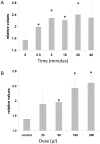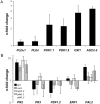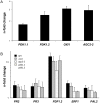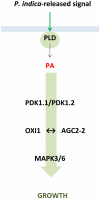The OXI1 kinase pathway mediates Piriformospora indica-induced growth promotion in Arabidopsis
- PMID: 21625539
- PMCID: PMC3098243
- DOI: 10.1371/journal.ppat.1002051
The OXI1 kinase pathway mediates Piriformospora indica-induced growth promotion in Arabidopsis
Abstract
Piriformospora indica is an endophytic fungus that colonizes roots of many plant species and promotes growth and resistance to certain plant pathogens. Despite its potential use in agriculture, little is known on the molecular basis of this beneficial plant-fungal interaction. In a genetic screen for plants, which do not show a P. indica- induced growth response, we isolated an Arabidopsis mutant in the OXI1 (Oxidative Signal Inducible1) gene. OXI1 has been characterized as a protein kinase which plays a role in pathogen response and is regulated by H₂O₂ and PDK1 (3-PHOSPHOINOSITIDE-DEPENDENT PROTEIN KINASE1). A genetic analysis showed that double mutants of the two closely related PDK1.1 and PDK1.2 genes are defective in the growth response to P. indica. While OXI1 and PDK1 gene expression is upregulated in P. indica-colonized roots, defense genes are downregulated, indicating that the fungus suppresses plant defense reactions. PDK1 is activated by phosphatidic acid (PA) and P. indica triggers PA synthesis in Arabidopsis plants. Under beneficial co-cultivation conditions, H₂O₂ formation is even reduced by the fungus. Importantly, phospholipase D (PLD)α1 or PLDδ mutants, which are impaired in PA synthesis do not show growth promotion in response to fungal infection. These data establish that the P. indica-stimulated growth response is mediated by a pathway consisting of the PLD-PDK1-OXI1 cascade.
Conflict of interest statement
The authors have declared that no competing interests exist.
Figures







References
-
- Peškan-Berghöfer T, Shahollari B, Giong PH, Hehl S, Markert C, et al. Association of Piriformospora indica with Arabidopsis thaliana roots represents a novel system to study beneficial plant-microbe interactions and involves early plant protein modifications in the endoplasmic reticulum and at the plasma membrane. Physiol Plant. 2004;122:465–477.
-
- Oelmüller R, Sherameti I, Tripathi S, Varma A. Piriformospora indica, a cultivable root endophyte with multiple biotechnological applications. Symbiosis. 2009;49:1–17.
-
- Selosse MA, Dubois MP, Alvarez N. Do Sebacinales commonly associate with plant roots as endophytes? Mycol Res. 2009;113:1062–1069. - PubMed
-
- Verma S, Varma A. Piriformospora indica, gen. et sp. nov., a new root-colonizing fungus. Mycologia. 1998;90:896–903.
-
- Shahollari B, Vadassery J, Varma A, Oelmüller R. A leucine-rich repeat protein is required for growth promotion and enhanced seed production mediated by the endophytic fungus Piriformospora indica in Arabidopsis thaliana. Plant J. 2007;50:1–13. - PubMed
Publication types
MeSH terms
Substances
LinkOut - more resources
Full Text Sources
Molecular Biology Databases
Miscellaneous

